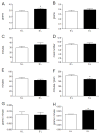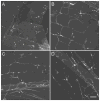Meal parameters and vagal gastrointestinal afferents in mice that experienced early postnatal overnutrition
- PMID: 20403369
- PMCID: PMC2900443
- DOI: 10.1016/j.physbeh.2010.04.011
Meal parameters and vagal gastrointestinal afferents in mice that experienced early postnatal overnutrition
Abstract
Early postnatal overnutrition results in a predisposition to develop obesity due in part to hypothalamic and sympathetic dysfunction. Potential involvement of another major regulatory system component--the vagus nerve--has not been examined. Moreover, feeding disturbances have rarely been investigated prior to development of obesity when confounds due to obesity are minimized. To examine these issues, litters were culled on the day of birth to create small litters (SL; overnutrition), or normal size litters (NL; normal nutrition). Body weight, fat pad weight, meal patterns, and vagal sensory duodenal innervation were compared between SL and NL adult mice prior to development of obesity. Meal patterns were studied 18 h/day for 3 weeks using a balanced diet. Then vagal mechanoreceptors were labeled using anterograde transport of wheatgerm agglutinin-horseradish peroxidase injected into the nodose ganglion and their density and morphology were examined. Between postnatal day 1 and weaning, body weight of SL mice was greater than for NL mice. By young adulthood it was similar in both groups, whereas SL fat pad weight was greater in males, suggesting postnatal overnutrition produced a predisposition to obesity. SL mice exhibited increased food intake, decreased satiety ratio, and increased first meal rate (following mild food deprivation) compared to NL mice, suggesting postnatal overnutrition disrupted satiety. The density and structure of intestinal IGLEs appeared similar in SL and NL mice. Thus, although a vagal role cannot be excluded, our meal parameter and anatomical findings provided no evidence for significant postnatal overnutrition effects on vagal gastrointestinal afferents.
Copyright 2010 Elsevier Inc. All rights reserved.
Figures




Similar articles
-
Early postnatal overnutrition: potential roles of gastrointestinal vagal afferents and brain-derived neurotrophic factor.Physiol Behav. 2012 Jun 6;106(3):400-12. doi: 10.1016/j.physbeh.2012.04.002. Physiol Behav. 2012. PMID: 22712064 Free PMC article. Review.
-
Neurotrophin-4 deficient mice have a loss of vagal intraganglionic mechanoreceptors from the small intestine and a disruption of short-term satiety.J Neurosci. 2001 Nov 1;21(21):8602-15. doi: 10.1523/JNEUROSCI.21-21-08602.2001. J Neurosci. 2001. PMID: 11606648 Free PMC article.
-
Reduced intestinal brain-derived neurotrophic factor increases vagal sensory innervation of the intestine and enhances satiation.J Neurosci. 2014 Jul 30;34(31):10379-93. doi: 10.1523/JNEUROSCI.1042-14.2014. J Neurosci. 2014. PMID: 25080597 Free PMC article.
-
Obesity and changes of alkaline phosphatase activity in the small intestine of 40- and 80-day-old rats subjected to early postnatal overfeeding or monosodium glutamate.Physiol Res. 2004;53(2):177-86. Physiol Res. 2004. PMID: 15046554
-
Gastrointestinal Vagal Afferents and Food Intake: Relevance of Circadian Rhythms.Nutrients. 2021 Mar 5;13(3):844. doi: 10.3390/nu13030844. Nutrients. 2021. PMID: 33807524 Free PMC article. Review.
Cited by
-
Perinatal programming of neuroendocrine mechanisms connecting feeding behavior and stress.Front Neurosci. 2013 Jun 17;7:109. doi: 10.3389/fnins.2013.00109. eCollection 2013. Front Neurosci. 2013. PMID: 23785312 Free PMC article.
-
Mechanosensation of the heart and gut elicits hypometabolism and vigilance in mice.Nat Metab. 2025 Feb;7(2):263-275. doi: 10.1038/s42255-024-01205-6. Epub 2025 Jan 17. Nat Metab. 2025. PMID: 39824919 Free PMC article.
-
Perinatal high-fat diet alters development of GABAA receptor subunits in dorsal motor nucleus of vagus.Am J Physiol Gastrointest Liver Physiol. 2019 Jul 1;317(1):G40-G50. doi: 10.1152/ajpgi.00079.2019. Epub 2019 May 1. Am J Physiol Gastrointest Liver Physiol. 2019. PMID: 31042399 Free PMC article.
-
Feeding circuit development and early-life influences on future feeding behaviour.Nat Rev Neurosci. 2018 Apr 17;19(5):302-316. doi: 10.1038/nrn.2018.23. Nat Rev Neurosci. 2018. PMID: 29662204 Free PMC article. Review.
-
Perinatal high fat diet increases inhibition of dorsal motor nucleus of the vagus neurons regulating gastric functions.Neurogastroenterol Motil. 2018 Jan;30(1):10.1111/nmo.13150. doi: 10.1111/nmo.13150. Epub 2017 Aug 1. Neurogastroenterol Motil. 2018. PMID: 28762595 Free PMC article.
References
-
- Fahrenkrog S, Harder T, Stolaczyk E, Melchior K, Franke K, Dudenhausen JW, Plagemann A. Cross-fostering to diabetic rat dams affects early development of mediobasal hypothalamic nuclei regulating food intake, body weight, and metabolism. J Nutr. 2003;134:648–654. - PubMed
-
- Ferezou-Viala J, Roy AF, Serougne C, Gripois D, Parquet M, Bailleu V, Gertler A, Delplanque B, Djiane J, Riottot M, Taouis M. Long-term consequences of maternal high-fat feeding on hypothalamic leptin sensitivity and diet-induced obesity in the offspring. Am J Physiol Regul Integr Comp Physiol. 2007;293:R1056–R1062. - PubMed
-
- Rocchini AP. Childhood obesity and a diabetes epidemic. N Engl J Med. 2002;346:854–855. - PubMed
Publication types
MeSH terms
Grants and funding
LinkOut - more resources
Full Text Sources

